Sulafat, Gamma Lyrae (γ Lyr), is a blue giant star located in the northern constellation Lyra. With an apparent magnitude of 3.261, it is the second brightest star in the constellation, after Vega. Sulafat lies at an approximate distance of 620 light years. It lies at the base of the parallelogram that outlines the pattern of the celestial lyre.
Star type
Sulafat is a blue giant of the spectral type B9 III. Some sources give the stellar classification A1 III, indicating a white giant. The star has a mass 5.76 times that of the Sun and, as it evolved away from the main sequence, it has expanded to a size of 15.40 solar radii. Its angular diameter was measured interferometrically at 0.74 ± 0.10 milliarcseconds.
With a surface temperature of 10,000 K, Sulafat is 2,430 times more luminous than the Sun. It spins faster than most stars in this class, with a projected rotational velocity of 71 to 72 km/s.
Facts
Sulafat is one of the six bright stars that form the main pattern of Lyra. The other five are Vega (Alpha Lyrae), Sheliak (Beta Lyrae), Delta Lyrae, Zeta Lyrae, and Epsilon Lyrae. The pattern represents the lyre of Orpheus, the Greek mythical musician who attempted to bring his wife Euridice back from the underworld and later met a tragic end at the hands of the Bacchantes. It is said that Zeus placed both the musician and his instrument into the sky.
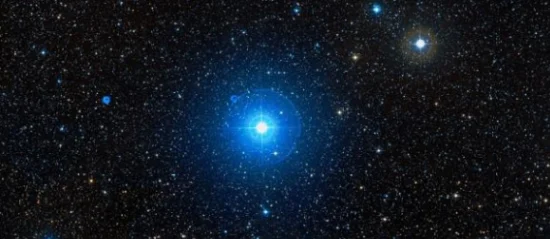
Sulafat (Gamma Lyrae), image: Wikisky
Sulafat was reported to be a spectroscopic binary system by Canadian astronomer Samuel A. Mitchell in 1909. Mitchell found an orbital period of 25.6 days. In 1978, Wolff also reported it to be a spectroscopic binary and found a period of more than 80 days for the system. The star was reported as a single-lined spectroscopic binary as recently as in 2001, but is now thought to be a single star with a high rotation rate for its type.
The brightness of Gamma Lyrae is decreased by interstellar dust by an extinction factor of 0.12 ± 0.03.
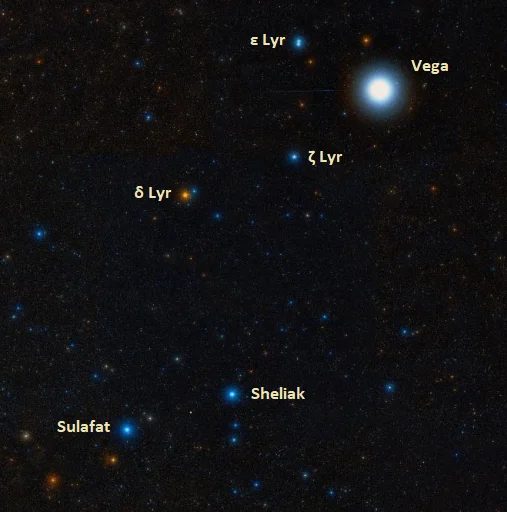
Lyra stars, image: Wikisky
Name
The name Sulafat (pronunciation: /ˈsuːləfæt/) comes from the Arabic al-sulḥafāt, meaning “turtle.” It is a reference to tortoiseshell, the material once used to produce fine harps. The name was also traditionally spelled Sulaphat. It was approved with the spelling Sulafat by the International Astronomical Union’s (IAU) Working Group on Star Names (WGSN) on August 21, 2016.
Gamma Lyrae was also traditionally known as Jugum, derived from the Latin iugum, meaning “yoke.”
The Chinese know Sulafat as 漸台三 (Jiāntāisān), the Third Star of Clepsydra Terrace. In Chinese astronomy, Clepsydra Terrace is an asterism formed by Delta2 Lyrae, Sheliak (Beta Lyrae), Sulafat (Gamma Lyrae), and Iota Lyrae. It represents water for clepsydra (an ancient water clock, used to measure time by the flow of water). The asterism is part of the Ox mansion, one of the northern mansions of the Black Tortoise.
Location
Sulafat is very easy to find because it is part of Lyra’s distinctive parallelogram pattern. Together with Sheliak (Beta Lyrae), it forms the base of the celestial lyre.
Lyra is easily found using the Summer Triangle, a conspicuous asterism that dominates the summer evening sky in the northern hemisphere. The Summer Triangle is formed by Lyra’s luminary Vega with Deneb in Cygnus and Altair in Aquila. Deneb sits at the top of the Northern Cross, another bright northern summer asterism, while Altair is identifiable as the star flanked by two other relatively bright stars, Tarazed and Alshain.
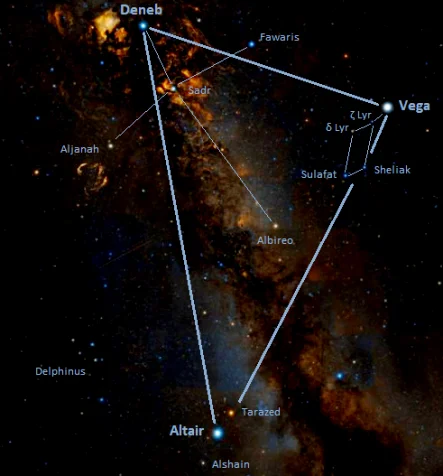
Lyra, the Summer Triangle and the Northern Cross, image: Wikisky
Sulafat and Sheliak can be used to find two bright deep sky objects, both discovered by the French astronomer and comet hunter Charles Messier in January 1779. The Ring Nebula (Messier 57), one of the brightest planetary nebulae in the sky, appears about halfway between the two stars. It has an apparent size of 230 arcseconds and lies approximately 2,567 light years away. With an apparent magnitude of 8.8, it is visible in modest telescopes, appearing as an oval blur between the two stars.
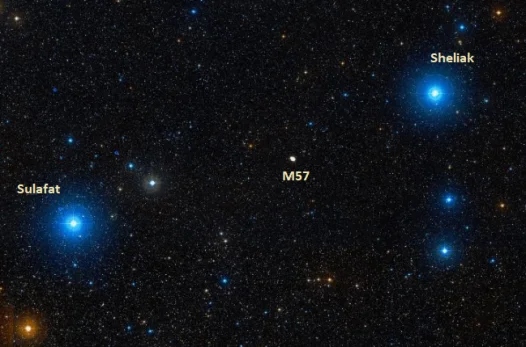
Sheliak (Beta Lyrae), Sulafat (Gamma Lyrae) and the Ring Nebula (Messier 57), image: Wikisky
Extending the imaginary line that connects Sheliak and Sulafat in the direction of Albireo at the base of the Northern Cross in Cygnus leads to the globular cluster Messier 56. M56 appears roughly halfway between Sulafat and Albireo (a bit closer to Albireo). It has an apparent magnitude of 8.3 and lies 32,900 light years away. Its brightest stars are of 13th magnitude.
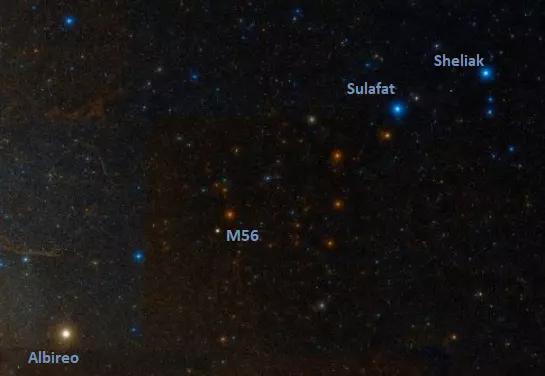
Albireo (Beta Cygni), Sulafat (Gamma Lyrae) and Messier 56, image: Wikisky
Constellation
Sulafat is located in the northern constellation Lyra. Representing the lyre of Orpheus, Lyra is one of the Greek constellations, first catalogued by Ptolemy of Alexandria in his Almagest in the 2nd century CE. It is one of the smaller constellations – the 52nd in size – occupying 286 square degrees of the northern sky between the larger Cygnus and Hercules.
Lyra is best known for being home to Vega, the fifth brightest star in the sky. Other notable stars include the multiple star system Epsilon Lyrae, popularly known as the Double Double, the variable red bright giant Delta2 Lyrae, the eclipsing binary pair Beta Lyrae, a prototype for a class of stars known as the Beta Lyrae variables, and RR Lyrae, a prototype for a class of pulsating variables.
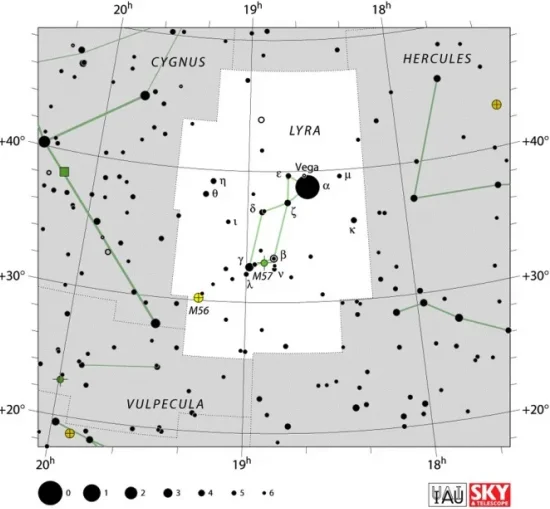
Lyra constellation map by IAU and Sky&Telescope magazine
Even though it is small, Lyra is well-known to deep sky observers because it hosts two bright deep sky objects: the Ring Nebula (Messier 57) and the globular cluster Messier 56. Other deep sky objects in the constellation include the open cluster NGC 6791, the irregular galaxy NGC 6745, the barred spiral galaxy IC 1296, and the planetary nebula Abell 46.
The best time of year to observe the stars and deep sky objects in Lyra is during the month of August, when the constellation rises high overhead in the evening sky. The entire constellation is visible from locations between the latitudes 90° N and 40° S.
The 10 brightest stars in Lyra are Vega (Alpha Lyrae, mag. 0.026), Sulafat (Gamma Lyrae, mag. 3.261), Sheliak (Beta Lyrae A, mag. 3.52), R Lyrae (mag. 4.00), Delta2 Lyrae (mag. 4.22), Kappa Lyrae (mag. 4.35), Zeta1 Lyrae (mag. 4.34), Theta Lyrae (mag. 4.347), Aladfar (Eta Lyrae, mag. 4.40), and Epsilon2 Lyrae A (mag. 4.59).
Sulafat – Gamma Lyrae
| Spectral class | B9 III |
| U-B colour index | –0.125 |
| B-V colour index | –0.047 |
| Apparent magnitude | 3.261 |
| Absolute magnitude | -3.14 |
| Distance | 620 ± 30 light years (190 ± 10 parsecs) |
| Parallax | 5.26 ± 0.27 mas |
| Radial velocity | -20.20 ± 0.6 km/s |
| Proper motion | RA: -3.09 ± 0.21 mas/yr |
| Dec.: +1.11 ± 0.27 mas/yr | |
| Mass | 5.76 M☉ |
| Luminosity | 2,430 L☉ |
| Radius | 15.40 R☉ |
| Temperature | 10,000 K |
| Metallicity | +0.15 dex |
| Rotational velocity | 71 – 72 km/s |
| Surface gravity | 4.06 cgs |
| Constellation | Lyra |
| Right ascension | 18h 58m 56.6224137s |
| Declination | +32° 41′ 22.400295″ |
| Names and designations | Sulafat, Gamma Lyrae, γ Lyr, 14 Lyrae, HD 176437, HR 7178, HIP 93194, SAO 67663, BD+32° 3286, AG+32 1705, FK5 713, PPM 82139, GC 26086, GCRV 11437, PLX 4407.00, ALS 15831, JP11 3059, IRAS 18570+3237, 2MASS J18585663+3241222, UBV 16130, TYC 2643-3346-1, Gaia DR2 2043823929419235328, ADS 11908 A, CCDM J18590+3242A, IDS 18552+3233 A, WDS J18589+3241A |